Follow this simple recipe and video tutorial for the best all butter pie crust. It will make you a pie expert immediately! Complete with all my tips and troubleshooting, this pie crust recipe is buttery, flaky, and tender with the most incredible flavor.
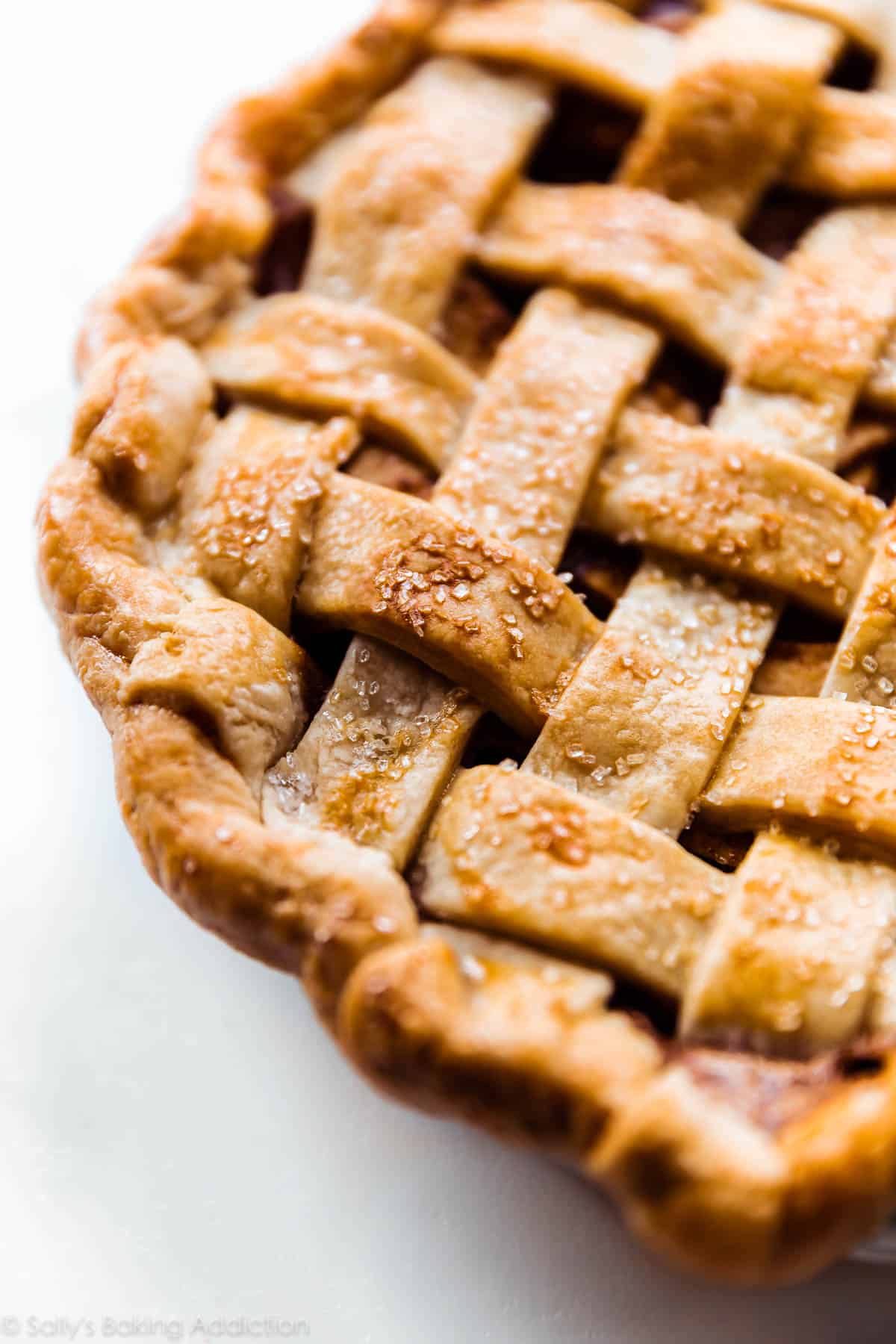
At the request of many, today I’m sharing my go-to all butter pie crust recipe. It competes with my butter and shortening pie crust for the #1 spot in my pie-loving heart. (Scroll to the recipe notes for my pie crust comparison!) I’ve made thousands of pies in my day and consider myself a pie expert. A pi-expert, if you will. I’ve made all the pie crust mistakes so I can coach you through the process and supply you with all the knowledge and confidence to tackle pie crust once and for all.
You’ll be a pi-expert with this recipe and tutorial on your side!
Watch my video tutorial for butter pie crust with lattice topping. This is my homemade apple pie with chai spices, a favorite every Fall season.
Start with a dependable pie crust recipe and you’re set for success. Soon everyone will be asking YOU for all your pie crust secrets.
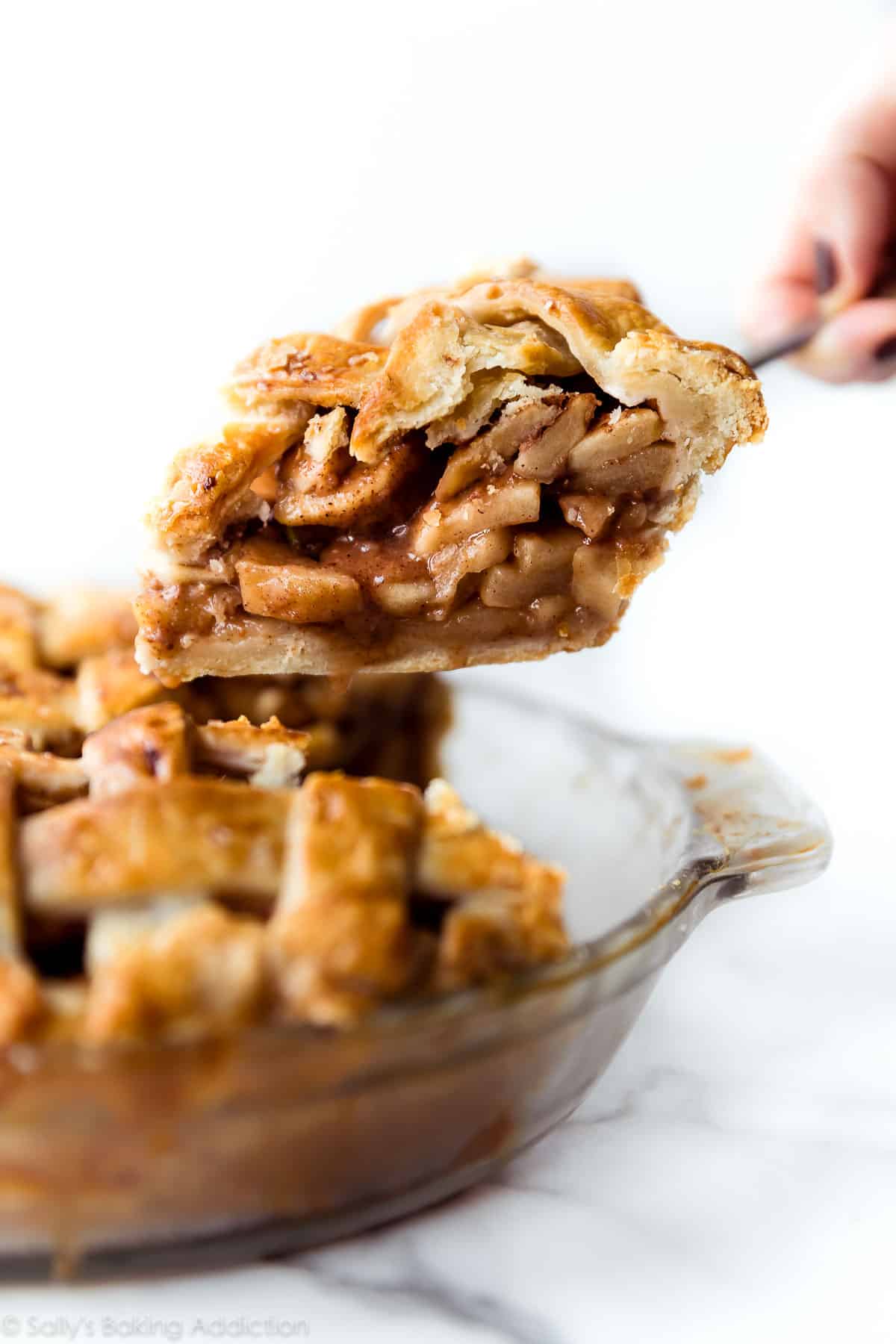
Only 5 Ingredients in Butter Pie Crust
This pie crust is made with 5 ingredients. Each ingredient has a very specific job. And with so few ingredients, it’s important to use the best quality.
- Flour – The structure of pie crust.
- Salt – Flavor flavor flavor. Use table salt instead of coarse salt. Smaller salt crystals dissolve and disperse more evenly throughout the dough.
- Granulated Sugar – Pie crust should not be sweet, but adding a little sugar to butter pie crust improves its flavor and enhances browning. The sugar crystals also help break down the hard pieces of butter.
- Cold unsalted butter – Supplies the pie crust’s unbeatable flavor and flaky texture. Use unsalted butter. The amount of salt in different brands’ salted butter varies, so for better control over the flavor, it’s best to begin with unsalted and add your salt.
- Ice water – The final ingredient, about 1/2 cup of ice cold water holds all the ingredients together. Use just enough so the dough holds its shape when rolling out. Many pie crust recipes don’t call for enough ice water, giving you a dry pie dough that cracks when you roll it out. When in doubt, add a little more water. You’re better off with more water (wet pie dough) than not enough water (dry, cracking pie dough) because you can always work more flour into the dough, but you can’t really add water to the pie dough when you’re trying to roll it out.
I use this crust in my apple cheddar pie—there I add some sharp cheddar cheese. It’s also the starting point for chocolate pie crust that we use for chocolate pop tarts!
Basic Pie Crust Steps
- Mix dry ingredients together.
- Cut in the butter with a pastry cutter or food processor.
- Add ice water a little bit at a time until the dough begins to come together. It will feel thick and moist, not overly wet. You’ll use around 1/2 cup (120ml).
- Mold pie dough into a ball.
- Cut in half. This recipe yields two 9-inch pie crusts.
- Flatten into discs. Wrap in plastic wrap.
- Chill for 2 hours before using.
These steps are shown in the video tutorial above and described in the recipe below.
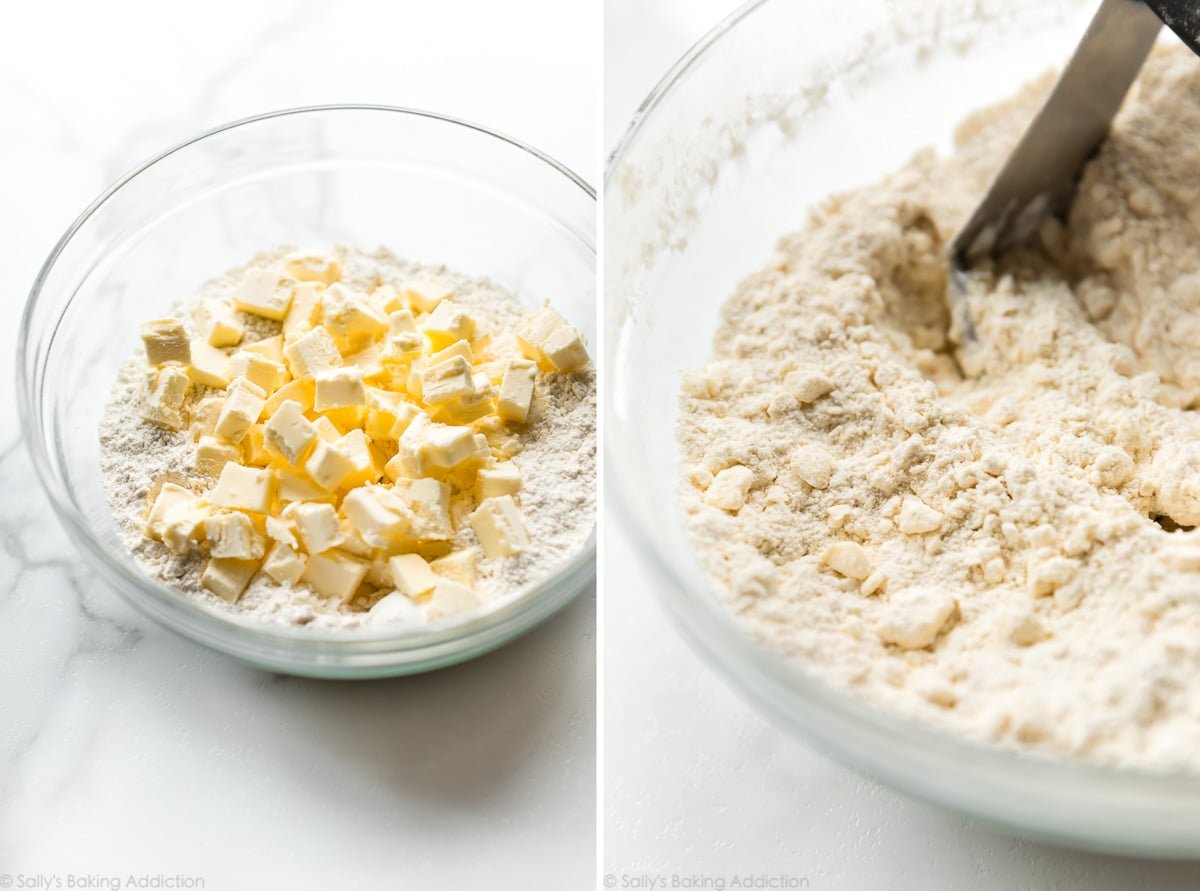
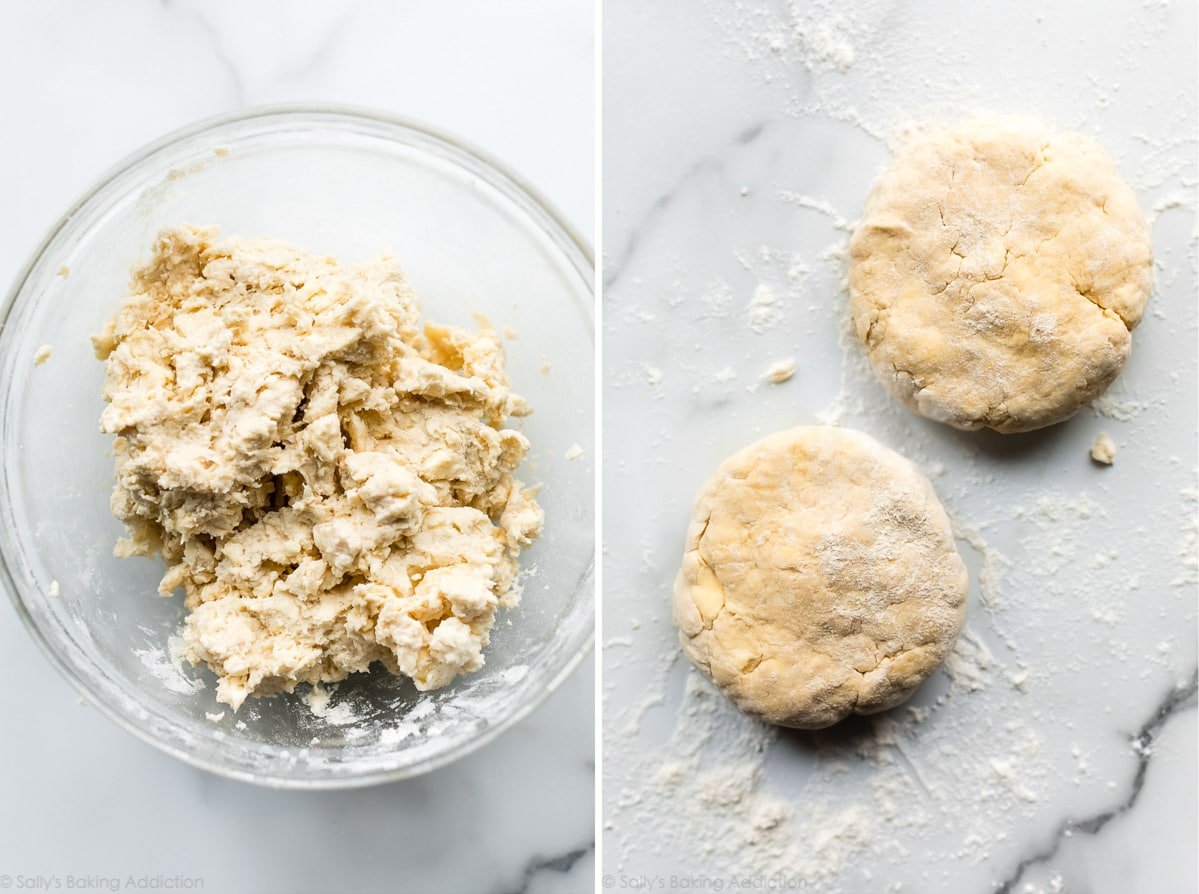
Why the Emphasis on Cold?
Keeping your pie dough as cold as possible prevents the fat from melting too soon. Too soon = before the pie crust enters the oven.
- What happens when the pie dough is warm? The butter in the pie crust will melt before baking, which means you lose all the flakiness and structure. Warm pie dough melts into a pool of grease. You’ll have a hard, crunchy, and greasy crust instead of a beautifully tender flaky crust.
- What happens when the pie dough is cold? The butter in the pie crust will melt inside the oven. Butter has a high volume of water content and this water converts to steam as the pie dough bakes. The steam separates the crust into multiple flaky layers, making this the most delicious pie crust ever.
The colder the dough, the flakier the pie crust.
How to Keep Pie Dough Cold:
- Use ice cold water. Fill a glass with 1 cup of water, add ice. You only need 1/2 cup of water in this butter pie crust recipe, but have a little extra just in case.
- Use cold butter. I keep some of my butter in the freezer and transfer it to the refrigerator a couple hours before beginning the crust. The butter is part frozen and very cold.
- Chill the pie dough for at least 2 hours before rolling out. This step is non-negotiable; it’s the most crucial in the entire pie crust recipe.
- For extra insurance, chill your flour and your mixing bowl in the refrigerator or freezer. Sounds a little silly, but trust me… it really helps!
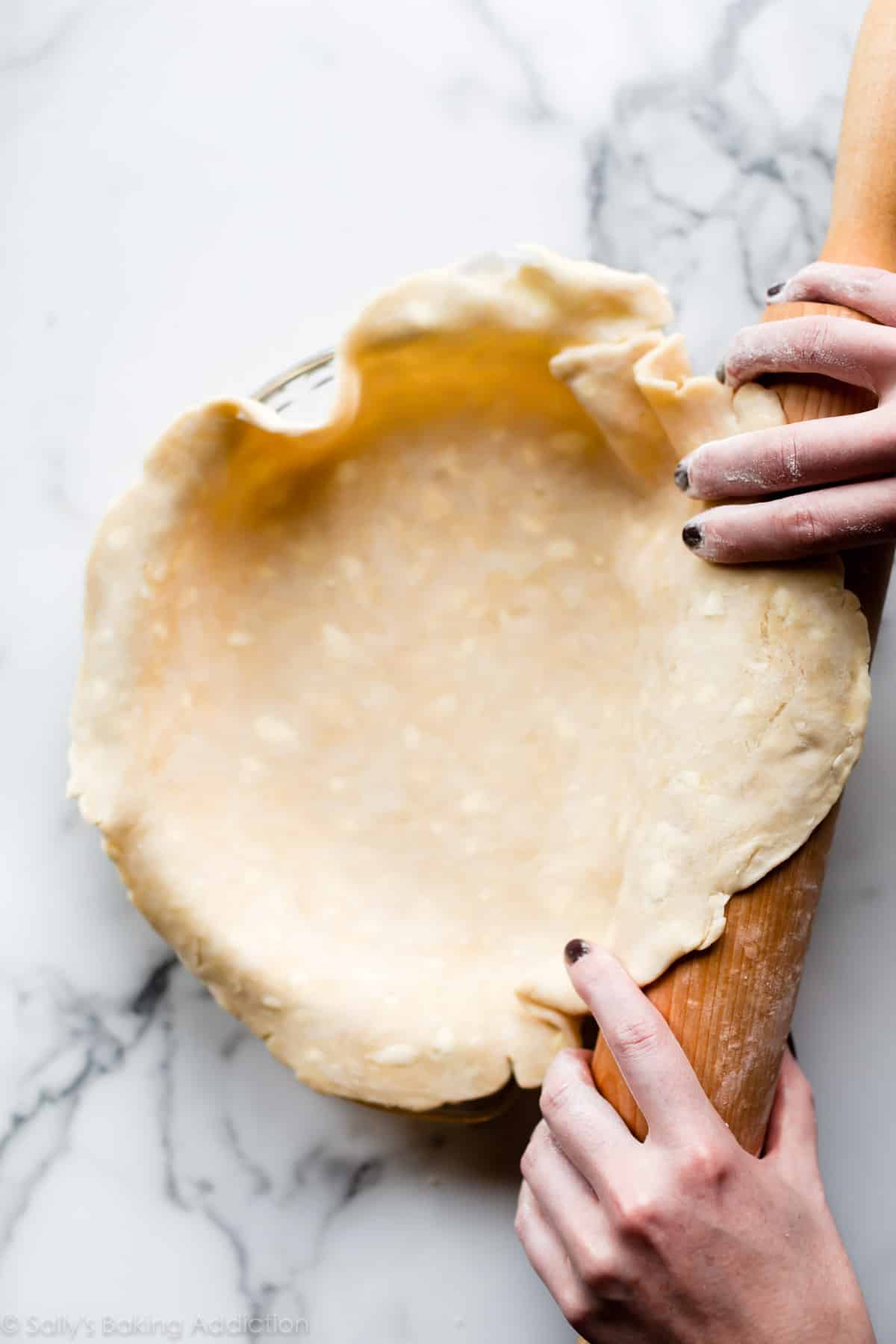
How to Roll Out Pie Dough
After the dough has chilled, it’s time to roll it out. Keep a small bowl of flour nearby to keep your work surface, rolling pin, and hands lightly floured. This prevents the pie dough from sticking. When rolling pie dough out, always start from the center and work your way out in all directions, turning the dough as you go. If the pie dough feels too warm or the butter is melting, stop. Lift it up, place on a baking sheet, and chill in the refrigerator for at least 10 minutes before continuing.
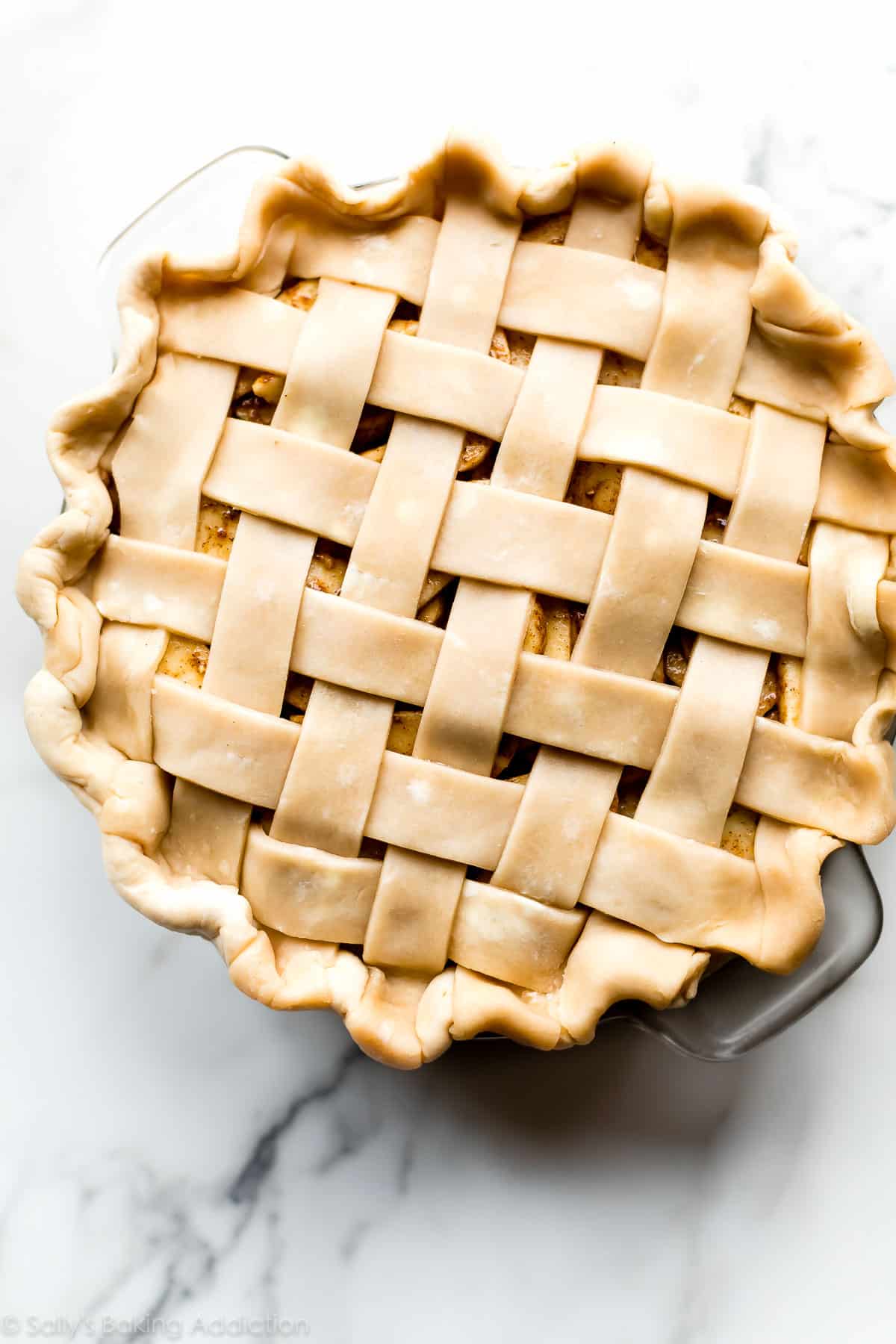
Butter Pie Crust Tips
- I’m going to repeat myself here. Keep all pie crust ingredients cold. On a hot day, you can chill the measured out flour in the refrigerator or freezer before starting. When taking the pie crust out of the refrigerator to roll out and fill, make sure your pie filling is ready to go. If not, keep the pie crust in the refrigerator until it is.
- Glass pie dishes are best. Why? As opposed to ceramic or metal pie dishes, glass pie dishes conduct heat evenly, which allows the bottom of the crust to bake thoroughly. Also, you can see when the sides and bottom of the crust have browned.
- If your pie recipe requires pre-baking (blind bake pie crust)—let’s say you’re making a pie with an especially wet filling—use pie weights or dried beans. Without pie weights, the pie dough will puff up, then shrink. Whichever you choose, be sure to line the crust with parchment or aluminum foil, then fill the empty pie crust with the weights. See my post and video tutorial for how to blind bake pie crust.
- Always use a pie crust shield. A shield keeps the crust edge covered, which protects it from browning too quickly or worse, burning. Use an adjustable silicone pie crust shield that you can fit to the size of your delicate pie crust. Metal can break the crust. Alternatively, you can cover the pie with a piece of aluminum foil. Cut a large circle in the center of the square so the center of the pie is exposed.
- Learn how to braid pie crust with my how to braid pie crust video tutorial.
- Learn how to lattice pie crust, too.
- Last but not least, learn how to crimp and flute pie crust. Those pretty decorative pie crust edges add function and flair!
Pie Crust Troubleshooting
- Prevent a crumbly pie dough that rips and tears when you roll it out. Make sure you use enough ice water when preparing your pie dough. Too little water creates an unworkable dough.
- Prevent a tough pie crust. Tough crusts are the result of not enough fat in the crust, as well as overworking the dough. Use the all butter pie crust recipe or my shortening and butter pie crust recipe to ensure a flaky, tender pie crust. Additionally, don’t work the dough too much.
- Prevent a burnt crust with a pie shield. See above.
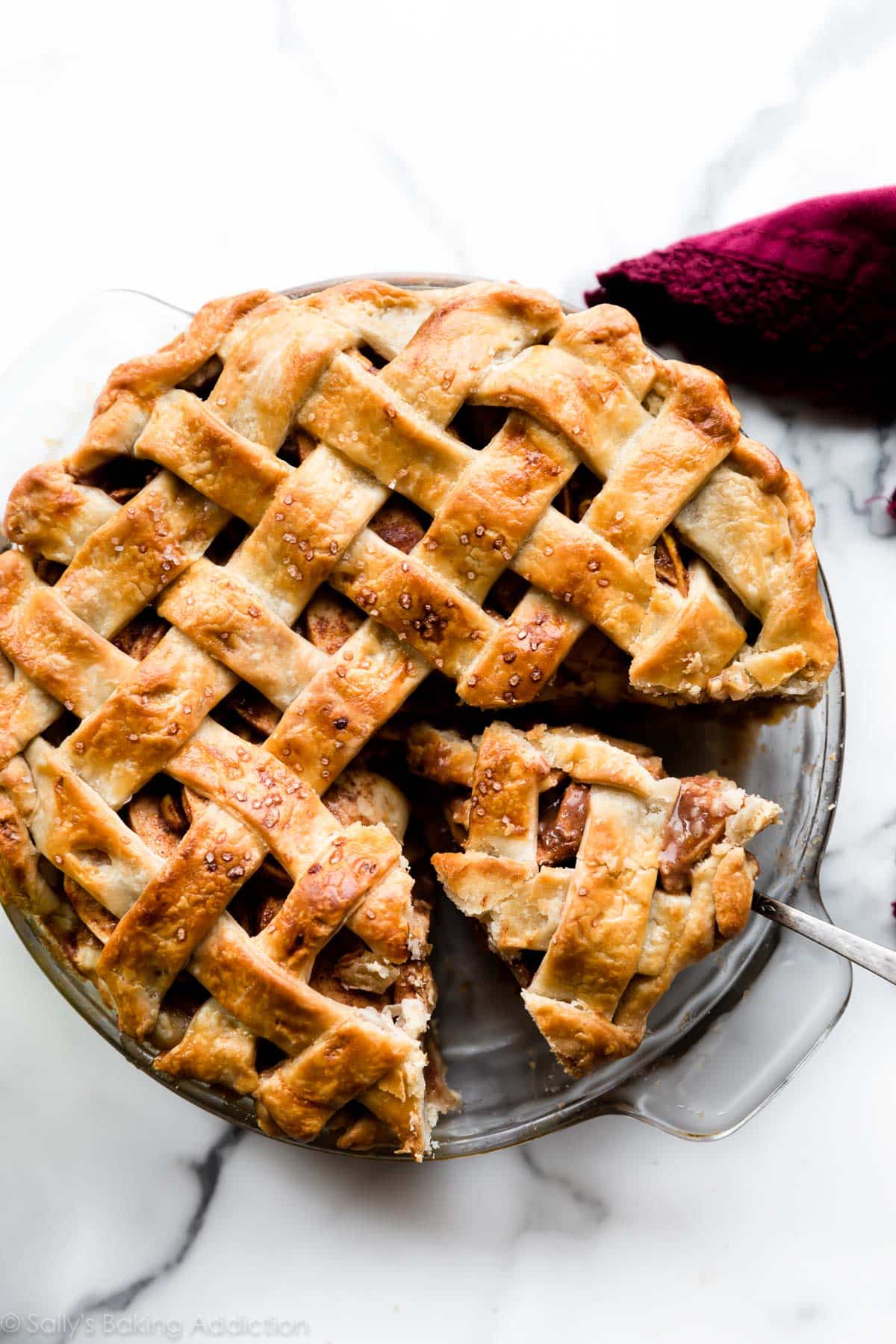
Recommended Pie Crust Tools
(All my recommend products are affiliate links. I trust these tried-and-true tools!)
- Pastry cutter – Though you can use a food processor to make this butter pie crust, I strongly recommend a pastry cutter to avoid over-mixing. Food processors are quick to over-work pie dough.
- Pastry mat – I prefer rolling pie dough out on a lightly floured counter because countertops are usually colder, but you can use a lightly floured pastry mat instead.
- Rolling pin – An obvious must with pie dough! I also love this marble rolling pin. Marble rolling pins are usually cooler to touch and we all know that pie dough loves the cold.
- Glass pie dish – My mother-in-law bought me this Pyrex pie dish 5 years ago and it’s been my go-to ever since. I have 4 of them now! Like I mention in my pie crust tips above, glass pie dishes conduct heat evenly, which allows the bottom of the crust to bake thoroughly. This is important. There’s no comparison, Pyrex is the best.
- Pizza cutter or pastry wheel – To cut your pie dough into strips for lattice decoration or any decoration. Have you seen my pie crust designs post?
- Pastry brush – An egg wash is simply an egg mixed with milk or water (usually milk). Lightly brush the pie dough with an egg wash using a pastry brush. The egg wash creates a golden, shiny, crisp crust. Without it, pie crust is dull and lacking color.
- Pie weights – These are crucial when you blind bake pie crust for no-bake or custard pies. Note: 2 packs of these pie weights is definitely needed!
- Pie crust shield – Pie crust edges are usually higher up than the center of the pie, leaving them exposed to the most heat. They brown quicker than the center of the pie, so it’s important to protect it with a shield. I usually place a pie crust shield on the pie about halfway through bake time. I recommend an adjustable silicone pie crust shield that you can adjust. Or you can cover the pie with a piece of aluminum foil: cut a circle in the center so the center of the pie is exposed.
Pie Recipes
Now that you’re fully prepared and equipped, here are several pie recipes to use your all butter pie crust. Pictured is my chai spice apple pie and I topped it with salted caramel in the video.
- Traditional Apple Pie & Salted Caramel Apple Pie
- Lemon Meringue Pie (a blind bake pie crust recipe)
- Caramel Pear Pie
- Pumpkin Pie
- Pecan Pie
- Banana Cream Pie (a blind bake pie crust recipe)
- Cherry Pie
- Peach Pie
- Blueberry Pie
- Sweet Potato Pie
- Fun recipes: Apple Hand Pies, Brown Sugar Cinnamon Pop Tarts, Pecan Pie Tarts
- Or any of my favorite Thanksgiving pie recipes!

All Butter Pie Crust
- Prep Time: 20 minutes
- Cook Time: 0 minutes
- Total Time: 2 hours, 20 minutes
- Yield: 2 pie crusts
- Category: Pie
- Method: Baking
- Cuisine: American
Description
Follow this simple recipe and video tutorial for the best all butter pie crust. It will make you a pie expert immediately! Complete with all my tips and troubleshooting, this pie crust recipe is buttery, flaky, and tender with the most incredible flavor.
Ingredients
- 2 and 1/2 cups (313g) all-purpose flour, plus more as needed (spooned & leveled)
- 2 teaspoons granulated sugar
- 1 teaspoon salt
- 1 cup (16 Tbsp; 226g) unsalted butter, chilled and cubed
- 1/2 cup (120ml) ice water, plus more as needed
Instructions
- Mix the flour, sugar, and salt together in a large bowl. Add the cubed butter on top.
- Using a pastry cutter, food processor, or two forks (pastry cutter is ideal, see post above), cut the butter into the dry ingredients until all flour is coated. You’re looking for pea-sized bits of flour coated butter. A few larger bits of butter is OK.
- Measure 1/2 cup (120ml) of water in a cup. Add ice. Stir it around. From that, measure 1/2 cup (120ml) of water since the ice has melted a bit. Drizzle the cold water in, 2 Tablespoons (30ml) at a time, and stir after each addition. Stop adding water when the dough comes together easily and begins to form large clumps. The dough will feel moist and a little sticky, but not feel overly wet. Do not add any more water than you need to. I always use about 1/2 cup (120ml) of ice water.
- Place pie dough on a lightly floured work surface. Using floured hands, fold the dough into itself until the flour is fully incorporated into the fats. Form it into a ball. Divide dough in half. Using your hands, flatten each half into a 1-inch thick disc.
- Wrap each disc tightly in plastic wrap and refrigerate for at least 2 hours and up to 5 days before using in a pie recipe.
- When rolling out the chilled pie dough discs, use gentle force with your rolling pin. Start from the center of the disc and work your way out in all directions, turning the dough with your hands between rolls. Smooth out the edges if you notice cracks. (See video above.) Keeping your work surface, rolling pin, and hands lightly floured makes rolling out easier.
- Proceed with the pie per your recipe’s instructions.
Notes
- Make Ahead Instructions: Prepare the pie dough through step 4 and freeze the discs for up to 3 months. Thaw overnight in the refrigerator before using in your pie recipe.
- Special Tools (affiliate links): Glass Mixing Bowl | Pastry Cutter | Silicone Spatula | Rolling Pin | 9-inch Glass Pie Dish | Pizza Cutter or Pastry Wheel | Pastry Brush | Pie Weights | Pie Crust Shield
- Pie Crust Comparison: Let’s see how this all butter pie crust recipe compares to my favorite buttery flaky pie crust, which uses a mix of shortening and butter. Due to butter’s high water content, this all butter pie crust is lighter textured with more defined flakes. As the crust bakes, the butter’s water converts to steam, creating thousands of deliciously light flakes. It’s also so buttery! However, because of all this butter, I find that the shortening and butter pie crust is a little easier to work with. Shortening has a higher melting point than butter, so the crust holds its shape wonderfully. Both crusts are fantastic, but if you are looking to make intricate pie crust designs I highly recommend my buttery flaky pie crust.
- Try This: Replacing 1 Tablespoon of ice water with cold apple cider vinegar creates an even flakier, more tender pie dough. It’s so tasty. Try it!



















Thank you for the recipe. The bread turned out very well. I added almost a cup more flour in order to get a mass that would stay together, and cooked at 400 for 55 minutes. Came out great
Thanks again
Oh my word!! The BEST crust ever!!
Thank you, this will be in my recipes forever
I used this recipe to make Sally’s cherry pie and omg I was SO impressed with how perfect it turned out. The best crust ever. I’ll be using this recipe for all crusts going forward!
I have used this recipe for the last few years…. its proven to be the best one!
I have been using this recipe for several years. We love it! Quick question though: can I omit the sugar? Does it change anything about the texture or taste (besides any sweetness obviously)?
Hi Kassi, if you’re looking for a crust for a savory recipe, you can use this crust as written for chicken pot pie (or any savory recipe). It’s not a sweet pie crust.
A little trick! I if you find your pie crust is in need of more water don’t add water directly to it add the water to your hands. That way you won’t add too much.
I have never before left a review but I couldn’t help it this time. I have been using this piecrust recipe for about two years. I have never had a fail. I even do it in my food processor being very careful not to overwork it and it turns out perfect every time. I also use all your instructions on how to blind bake a pie and par bake a pie. Perfect. It just turns out perfect. Thank you for making my pies delectable. I’m always the one they call on when they want a good pie and that’s because of you. Thank you.
Thank you for sharing your review, Rose-Marie! We are so happy you’ve had great success with this recipe.
As always, thank you for this recipe! I live in a country where shortening is not common, so to have an all-butter pie crust recipe that works is just heaven sent.
At first I was sceptical about the suggestion to replace some of the iced water with ACV, but next time I will give it a try! I would love to find out what it does to the texture, and I believe it would also make the taste of the pie crust more complex and complementary to all sorts of fillings.
I used this pie crust for an apple pie, which I made based on Sally’s Deep Dish Apple Pie. I am so excited to find a dessert recipe that only uses a fraction of the sugar typical in recipes such as cake, cookies and custards.
In the case of make ahead, this recipe suggests waiting for “pie day” to roll out the crust, and chilling the dough as a ball until then. But I didn’t have time for that, so I just plated and latticed my crust ahead, and as suggested by other sources on the internet, pre-baked it with egg wash to prevent my pie from turning out soggy. Which comes with a caveat…
I know this recipe is supposed to yield “two crusts” (one for the shell and one for the top) but because I pre-baked this crust ahead of pie day, this recipe did not yield enough crust for me.
My pie crust shrunk considerably! I crimped my pie crust generously over the rim of of my pie plate. But by the time I took the crust out of the oven, I mostly had nothing over the rim except for this awkward pear-shaped corner which happened to roll a tad thicker. It’s not like I measure every surface of the dough like oh how many millimetres is this. So unfortunately my pie turned out ugly.
The lattice top was pretty as dough but super tricky to put on the shell. Pieces of crust just kept falling off the sides. It was also impossible to shape it into a perfect circle. So yeah, once again, I got an ugly pie.
So my advice for people planning to pre-bake this pie crust is to double this recipe! Seriously, there is no such thing as too much pie crust. Your crust will shrink, so measure considerably more than you think you need. If you make this recipe exactly, you will end up with “just enough” crust up the walls of your pie plate and “just enough” for your lattice top, but you won’t have any slack to work with to make up for the shrinkage. Not to mention that when you’re working with rolled dough that needs cutting up, there is no way you will use 100% of the batch. There will always be some leftovers that won’t make it to your pie.
If I doubled this recipe, that means that I can plate and lattice my crust for pre-baking, AND still have dough that I can chill till pie day to fix any hiccups such as uneven shrinkage, and actually sealing the lattice to the shell. You definitely need wet dough for that, and can’t do anything about it if all your pie crust is already pre-baked.
Anyway, great recipe, but highly recommended to double even this. And if you end up with a lot of excess crust afterwards, you could just cut them up into squares, spread jam and icing on them, and turn them into easy homemade Pop Tarts. Or throw in some eggs, ham and spinach for a delicious breakfast quiche.
This is the recipe for pie crust that I’ve been using for about 30 years. It’s always perfect. I highly prefer an all-butter pie crust over one made with shortening. I hope everyone gives this a try, it’s so much easier than you think if you own a food processor. I grew up helping my mom make pie crust with a pasty cutter. While I’m glad to have that skill, the food processor makes this so simple that making pies is a lot more fun.
This was the best pie crust I’ve ever eaten or made!
Anyone know what went wrong if the dough is tough to cut and chewy? Baking temperature too low? Butter pieces too big/not incorporated enough? What can I do better with the second half of the dough?
Hi Alex, it sounds like the pie wasn’t finished in the oven– don’t be worried if your pie takes longer than what a recipe suggests. All ovens are different. Even 10 more minutes in the oven would help for next time.
I want to use this recipe for making 9″ and 5″ quiches where the contents/filling do need to cook a bit (20-30 minutes). Is it essential to “blind bake” the crust before filling it with egg mix and other fillings? I’ve tried it both ways and neither has been ideal.
Hi Dre, You may find this post on how to make the perfect quiche helpful. We do recommend blind baking the crust.
Best pie crust ever, I get glowing compliments every time I use it! The only downside is now I’m the designated pie maker for all occasions — be careful out there….. 😉
Used this to make pecan pie. My crust was very tough. Couldn’t cut with a fork. It did not appear over baked. Any suggestions?
Hi KJ, Overworked pie dough will taste tough when baked. See if you can cut your butter into smaller pieces before working into the dough. That way you won’t have to work it so hard. I hope this helps for next time.
I froze the butter & grated it into the flour. So, I’m thinking I must’ve overworked it then. Thank you!
I made this for Thanksgiving and got rave reviews! Only the second time we have tried homemade crust and I think this is going to be my go to from now on. I made it Wednesday night, let it chill overnight and then rolled it Thursday morning, popped it back in the fridge to chill again, and then filled and baked it while we ate. It worked wonderfully! It did roll a bit better after warming up for about 30 minutes on the counter (the first round only sat for about 20 and was pretty stiff).
givin’ this a whirl for Thanksgiving in 36 hours, along with your Great Pumpkin Pie recipe. I want a chocolate pastry crust. Can I add some unsweetened Dutch cocoa to this? Would I need to add more ice water? Better yet—do you have any suggestions for a chocolate crust? Thank you!
Hi Cary! Here’s our recipe for chocolate pie dough – this recipe makes enough for two crusts as well.
There’s no link and I couldn’t find one with a search. Do you have a recipe for a chocolate pie crust dough?
Here’s our chocolate pastry/pie dough recipe!
Where is the recipe for the lattice? Should I be using the second disc for it?
Hi Katerina, yes you will use the second disk to make the lattice top.
Hi Sally! I’m planning to make your blueberry pie with a lattice top and braided crust. Would you recommend I use your shortening/butter crust recipe or your all butter recipe for this? I ask because I see you recommend all-butter for intricate crusts, but you mentioned that the shortening/butter crust is more forgiving! (This will be my first time making a top crust)
Hi Marie, We actually do recommend the shortening/butter crust for intricate designs since it’s a little easier to work with and has a higher melting point. It’s called buttery flaky pie crust, sorry if there was any confusion!
Hi – are there any guidelines for when to pre-bake a pie crust and when not to? I’m making pecan pie. Should I pre-bake the crust or should the crust bake with the filling? Thanks!
Hi Anne! Here’s our guide to par-baking pie crust. Usually you par-bake when you have a no-bake filling or a filling that doesn’t need to bake for very long. We don’t par-bake the crust in our pecan pie recipe because the filling needs to bake for quite a long time to set up, so the crust bakes at the same time. Hope this helps!
Thank you!
Help! I just realized that I accidentally used salted butter. Will my crust be totally inedible or still okay? For an apple pie if that helps.
Love this recipe and have made it a ton (and until this time correctly!)
Hi Ayla, the crust will turn out just fine. It may taste *slightly* saltier than normal, but will be fine with the apple pie!
Thanks for saving me from panic making a new one!!
First, thank you for the amazing recipe. This is my go to crust and it always comes out fantastic! With Thanksgiving coming, I would like to double or triple this recipe and freeze. Should I just double the ingredients all at once or make two separate batches? Thank you in advance!
Hi Lisa! In order to prevent over or under working the dough, we recommend making separate batches.
I have been bouncing between this pie crust and the Martha Stewart crust for years (this one for a double portion; the other works well for a single crust but doesn’t seem to double well). I don’t eat lard, and always have butter on hand. This time I tried a little something different and it was amazing – I didn’t have enough butter but I did have some Ghee (clarified butter). I used about 3T Ghee and the rest regular butter and the taste was oh so buttery and flakey. I don’t know if it adds the consistency that lard does, but I would recommend giving that a shot if you want extra buttery tasting crust.
Hi Sally! I used this pie crust with your crumble apple pie and the bottom didn’t cook all the way, even though it was in the oven for an additional 30 minutes on top of what the apple pie called for. I’m not too sure what happened… the sides of the pie looked beautiful and golden brown and flakey but the bottom just wouldn’t bake… Was I supposed to blind bake the crust before hand or is that something I should do next time? I really want to make this pie for Thanksgiving if I can become successful at baking it! Please HELP!
Hi Amanda, are you using a glass pie dish and can see that the bottom crust isn’t done yet? If you want to try the recipe again, it would be easy to par-bake this crust and you can follow the directions on our How to Par Bake Pie Crust page. We would partially par-bake it according to those directions, then add the apple filling and topping.
I’ve been using this recipe for years and it is perfection! I do add a splash of apple cider vinegar to my ice water and I grate my butter to assist with cutting it in. It is so flakey, easy, and delicious! I’ll never use another recipe. Store bought crust is
Can this pie crust be used with a chicken pot pie?
Absolutely!
Would that be a crust that needed blind baking?
Hi Jennifer! We don’t blind bake the crust in our chicken pot pie recipe.
I made a great pumpkin pie this weekend using your recipe (and your pumpkin pie filling- with some extra cloves). If I wanted to omit the sugar and use this for a chicken pot pie, should I replace it with some extra flour or something…or just make the rest of the recipe as written?
Hi Ali, we’re so glad you enjoyed the pumpkin pie! You can use this crust as written for chicken pot pie (or any savory recipe). It’s not a sweet pie crust.
Made this recipe for Thanksgiving to go along with your pumpkin slab pie and it turned out amazing! People were raving about the pie! I’m making it again today for my chrisrmas pies!
Help! I accidentally put lemon juice in my pie crust instead of water. I had it measured in a cup for the filling. I mixed the crust up and it felt normal, then wrapped & put in fridge. Realized later that it was lemon juice. I know it would taste really tart, but what if I sprinkled sugar over the crust as I roll it out and use it for my lemon meringue pie? I hate to throw it out!
Hi Brenda, we haven’t tried it so it’s hard to say, but it’s worth a shot! Let us know how it goes for you.
For a while I couldn’t decide between an all-butter or a half butter half lard mix. I’m now pretty set on this one. Tasty and flaky.
I love this recipe! Do you have any tips or tricks to possibly make the dough in a food processor?
Hi John, While you could use a food processor to make this pie crust, we recommend using a pastry cutter, or even two forks, to avoid over-mixing. Food processors are quick to over-work pie dough.
I have to make this recipe dairy-free, so I’m using margarine instead, the dough didn’t come together as well as it does with butter – any suggestions for a dairy-free crust?
i want to make only 1 pie crust, should i reduce the flour, water and butter by half?
For half the recipe (1 crust), simply halve all of the ingredients.
Not sure what I did wrong, but when blind baking the crust there was butter coming out of the crust everywhere. Used it for a quiche and the crust is as hard as a rock outside and raw inside….help
Hi Laura! It’s normal for the butter to melt and pool a bit as the crust blind bakes. Make sure to keep the crust very cold as you’re working with it – and don’t add more water than needed to bring the dough together. Here’s our post on blind baking crusts with more information!
Thank you so much for your reply and tips. I will be giving it another shot this weekend with a peach pie. I am sure this one will be super!
I LOVE this pie dough, always delicious and flakey. For my oven, turning the temp up to 425 for blind baking has better results with less butter melting and less shrinkage.